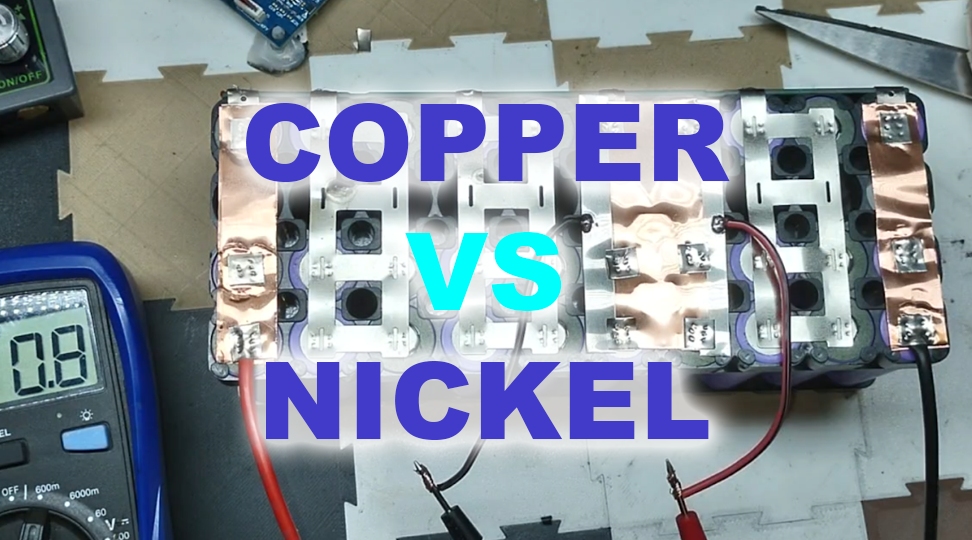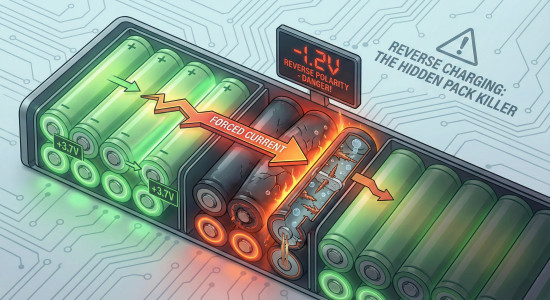
Copper vs Nickel in Lithium-Ion Battery Series Conductors: Real-World Voltage Drop & Resistance Tests
Table of Contents
Introduction
This is a 10S 3P lithium ion battery. You can see it uses nickel as the series conductor. This is a 13S 4P lithium ion battery. And it uses copper as the series conductor. Copper is used because it has a significantly lower resistance than nickel. That means it has a lower voltage drop and can carry a much higher current.
This is a 4P battery for a 30 amp bike, so copper is almost entirely unnecessary for this. This is just how I build batteries. With this particular battery, I have the copper welded directly onto the cells with nickel only on the top. But that doesn't have to be the case. You can definitely do nickel welds like this and do copper on the top and get the same benefit. And I'm going to prove that in this article.
Test Jig Setup
I made this test jig that allows me to swap in and out different metal strips to see what their performance is. As you can see how it works, the strip goes in and this screw presses it down on this copper plate. The copper is wrapped around each one. So let's put in this nickel strip. It's 0.15mm thick. I think it's 7mm wide. And let's see what kind of voltage drop performance it gets.
Nickel Strip Voltage Drop Test
Okay I'm putting 1 amp into the strip and it's producing 8.4 millivolts of voltage drop. Now watch what happens when I increase the current. As you can see the voltage drop across the strip is linearly proportional to the amount of current that's flowing through it.
As I touch this and feel the warmth my body is absorbing some of that heat energy. That's how I can feel it. That means I'm reducing the temperature of that strip. And that's going to decrease its resistance which is going to lower its voltage drop and that's what we're seeing right there.
Copper Strip Voltage Drop Test
So now let's see what the copper strip does. Significantly lower voltage drop.
So now let's combine them in real time using this other post and see what happens to the voltage drop. It's already making a little bit of a connection there.
And there we go. So, what do you think the voltage drop across the nickel is now? And as you can see they are almost the same. The reason why they're practically the same is because the copper and the nickel each have their own millivolts of drop that they will apply for a given amount of current. Because their resistances are different, different amounts of current are going to the two strips. The majority of the current is going through the copper because the copper has the lowest resistance. But a proportional amount of the current is going through the nickel.
Any time you add resistors in parallel the overall resistance is always going to be lower than either of those things on their own. Some people think that adding a higher resistance material to a lower resistance material that's used as a series conductor either won't give you any benefit or will actually lower performance. But this proves that that is false.
Real-World Battery Test
Test Preparation
Here's a real battery. I welded some main connections to it for the test and I made this test load out of a piece of nichrome wire and it's sized just right to draw a third of the current of the volts that you give it. So if you give it 10 volts, it'll pull 3.33 amps. If you give it 100 volts, it'll pull 33.33 amps. We're going to give it around 40 volts. Here check it out. I'm going to be running it in water but I'll just run it here like this so you can see. It definitely works. That's about 500 watts right there.
Under-Load Voltage Drop
Okay, now we have about 13 amps flowing. And there we go. Now we have voltage drop in the same way that we had on the test jig.
Tab Welding for Consistent Monitoring
Okay, I have the load disconnected for now and I'm going to weld on some tabs on either side here so we can monitor that without me having to hold the probes on there. Okay, and here we are. Current is flowing, which produces a voltage drop across this series conductor.
Because we know how much current is flowing and we know the mv of voltage drop, the resistance of this 4P nickel strip across the 4 lanes can be computed as 569 microOhms.
Incremental Copper Addition
What do you think is going to happen when I weld on a 25mm copper sheet? I'll give you a sneak peek. I'm just going to press it on.
First Copper Tab
Okay so let's weld it. I'm going to plug the load in. There it goes. And there we go. It's cooling so its resistance is lowering and its voltage drop is lowering.
Second Copper Tab
So let's weld another piece of copper on to see what happens. I'm already down to 0.8 millivolts and this isn't a very expensive meter. So I need to increase the current which will increase the voltage drop and make it easier to see it when we lower the voltage drop by adding more copper.
Increasing Load Current
This nichrome wire has a certain amount of resistance per foot. If I reduce its length I will lower its resistance which will cause more current to flow. I think the easiest way to do that is to just short out a few of these coils. I don't know exactly how much this will cause the current to increase but it will increase at some amount.
Shorting Nichrome Loops
I pulled 4 loops together in this nickel. I'm going to weld over it. That was very difficult but I think I got it. Okay the load is back in the water. Let's see what kind of voltage drop we're getting now. Remember before we were getting 0.8 millivolts.
Okay not much more, so I did another one with way more loops. This should pull way more current. Okay I guess that's enough.
As you can see, it's producing 1.3mv of voltage drop instead of the original 0.8mv. When the series conductor had a voltage drop of 0.8mv, it was handling 13 amps of current. Because the voltage drop has increased to 1.3mv, it means the current is now around 21 amps.
Because we know the current and the millivolts of drop across the series conductor, we can calculate the resistance between the two probes as 62 microOhms. Compare that to the 569 microOhms using nickel alone. The reason why the resistance has decreased so dramatically is because we are not only adding copper to nickel, but we are also adding a solid material on top of strips. That’s why the benefit is so massive.
Second Copper Strip (Copper on Copper)
Let's weld on another piece of copper and see what happens to that voltage drop. We are now getting just 0.7mv of voltage drop under a 21A load. That results in a result of around 33 microOhms.
Conclusion
It can be clearly seen that there's absolutely no problem adding copper on nickel or copper on copper. Yes electrons take the path of least resistance and all that but they don't ignore paths. The current is distributed proportionally. This becomes a composite resistor that has new characteristics. That's composed of several different resistances that all exist at different planar heights.
We hope this article helped you gain a better understanding of series conductors and resistance. Thanks for reading!


